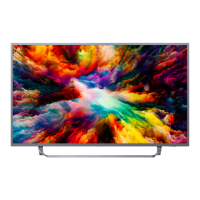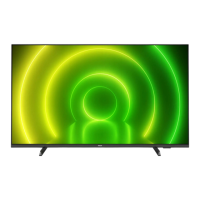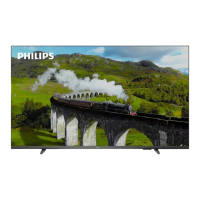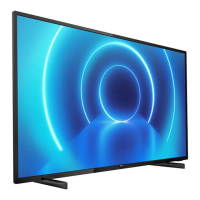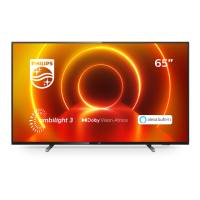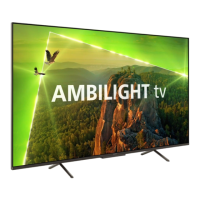Do you have a question about the Philips 43PUS7303 and is the answer not in the manual?
Essential safety instructions to follow before operating the TV.
Guide to installing the TV stand or mounting it on a wall.
Recommendations for optimal TV placement for viewing and Ambilight.
Instructions for connecting the TV's power cable securely.
Details on connecting the antenna cable for TV signal reception.
Explanation of the buttons and functions on the remote control.
Steps to pair the Bluetooth remote control with the TV for advanced features.
How to use voice commands for searching content and controlling the TV.
Information about the infrared sensor for remote control command reception.
Instructions on how to replace the batteries in the remote control.
Guidance on how to clean the TV remote control safely.
How to switch the TV on from standby or put it into standby mode.
How to perform basic TV operations using keys directly on the TV.
Information about how channels are displayed in the channel list.
How to sort and filter channels within the channel list.
Instructions on how to tune into and switch between TV channels.
Guide to creating and managing custom lists of favorite channels.
How to access and navigate Text and Teletext services on the TV.
Information on using interactive TV services like HbbTV.
Steps for installing and configuring satellite channels on your TV.
Guide to installing channels via antenna (DVB-T) or cable (DVB-C).
Instructions for copying and uploading channel lists using a USB drive.
How to copy satellite channel lists between compatible TVs.
General advice on connecting devices for the best quality experience.
Guide to installing and using a CI+ module for premium TV channels.
Instructions for connecting HTS, soundbars, or disc players via HDMI.
Methods for connecting mobile devices to the TV wirelessly or via MHL.
How to connect a Blu-ray player to the TV for optimal viewing.
Instructions for connecting a DVD player to the TV.
Steps to pair Bluetooth devices like gamepads or headphones with the TV.
How to connect headphones to the TV for private listening.
Guide to connecting game consoles to the TV via HDMI for gaming.
Instructions for connecting and formatting a USB hard drive for recording.
How to connect a USB keyboard for text input and navigation.
How to view photos, music, and videos from a USB flash drive.
How to connect a digital camera to the TV to view photos.
Guide to connecting a camcorder to the TV for video playback.
Information on using HDMI connections for high-quality video and audio.
How to connect a computer to use the TV as a PC monitor.
Prerequisites and steps for connecting the TV to a home network via Wi-Fi or Ethernet.
How to sign in with a Google Account to access Android TV features and apps.
Guide to installing and using apps from the Philips App Gallery.
Overview of apps available on the TV, including Google Play and App Gallery.
Using Google Play for movies, music, games, and app purchases.
How to install apps from the App Gallery and agree to terms of use.
Instructions on how to launch and close applications on the TV.
Setting up app locks and restricted profiles for child safety.
Tips for managing app performance, cache, and uninstallation.
Checking TV storage and extending it using a USB hard drive.
How to launch and use the TV's built-in internet browser.
Exploring features like speed dial, bookmarks, and private browsing.
Understanding the TV Menu as an alternative to the Home Menu.
How to access and navigate the TV Menu to find functions.
How to select and switch to different connected input sources.
Setting specific options for connected TV input devices.
How to rename devices or change their type for easier source identification.
Updating the Sources menu to detect newly connected devices.
Information on connecting the TV to a network.
Guide to pairing, selecting, and removing Bluetooth devices.
Choosing preset picture styles or customizing your own.
Guide to selecting sound styles and accessing expert sound settings.
How to turn Ambilight on/off, select styles, and adjust brightness/saturation.
Adjusting energy saving levels, screen off timer, and ambient light sensor.
Configuring USB drives, keyboards, and other general TV settings.
Setting up TV for shop display and configuring HDMI Ultra HD settings.
Adjusting TV time, region, language, and teletext preferences.
Configuring Android settings and accessibility features for users.
Setting up child locks, parental ratings, and app locks.
How to view videos from network-attached storage or computers.
Adding and viewing favorite files from various sources.
Accessing recently played or popular media files.
Playing videos, photos, and music from USB drives or hard drives.
How to play videos, use playback controls, and set video options.
How to view photos, use slideshows, and manage photo favorites.
How to play music, use playback controls, and manage music favorites.
Information on viewing current and scheduled TV programs.
Understanding where TV guide information originates from.
How to navigate, tune to programs, and view details in the TV Guide.
Instructions on how to record live or schedule future TV broadcasts.
How to pause live TV broadcasts and replay recent moments.
Using the mobile app to control the TV and stream media.
How to cast apps from mobile devices to the TV screen.
How to enable AirPlay functionality on your Android TV.
Connecting MHL-compliant mobile devices for screen mirroring and charging.
Requirements for playing games, including internet and gamepads.
Information on connecting gamepads for interactive gaming.
How to start and play games available on the TV.
Selecting Ambilight styles like Follow Video, Audio, Colour, or Flag.
Instructions on how to disable the Ambilight feature.
Understanding how Top Picks recommends TV programs and services.
Viewing popular programs currently airing or starting soon.
Accessing missed TV programs through Catch Up TV or Replay TV services.
Renting movies and TV shows from online video stores.
Understanding the Home Menu as the central hub for TV functions and apps.
How to open the Home Menu and launch applications or switch sources.
Restricting TV access to specific apps using a PIN code.
How to update the TV software from the internet or a USB drive.
How to view the current TV software version and release notes.
Enabling automatic software updates for seamless TV maintenance.
Details about the open source software used in the TV.
Information regarding the licenses governing the open source software.
How to receive announcements about new TV software or related issues.
Details on energy efficiency, product disposal, and battery safety.
Technical details about the TV's power requirements and consumption.
Information about the TV's operating system (Android Nougat 7).
Technical specifications for TV signal reception (Aerial, DVB, Satellite).
Specifications for screen size, resolution, and input resolutions.
Details on available ports and interfaces like HDMI, USB, and Audio Out.
Information on the TV's audio output power and supported audio formats.
Supported video, audio, and subtitle codecs and file system formats.
Benefits and steps for registering your Philips TV for support.
How to access and navigate the TV's built-in help and support features.
Solutions for problems like TV not switching on or remote control issues.
How to find help and product information on the Philips support website.
Information on contacting Philips Customer Care for support and repairs.
Important safety instructions to prevent electric shock, fire, and injury.
Guidelines for safely cleaning and maintaining the TV screen.
Legal terms and conditions governing the use of the TV product.
Terms for Smart TV features, privacy policy, and settings.
Terms and conditions for using apps from the Philips App Gallery.
Information about MHL trademarks and their usage.
Details about the Ultra HD logo and its meaning.
Information regarding HDMI trademarks and licensing.
Information about Dolby Audio trademarks and licensing.
Information about DTS-HD Premium Sound trademarks and patents.
Information regarding Microsoft Windows Media and PlayReady.
Information about Wi-Fi Alliance trademarks and logos.
Information about Kensington trademarks.
Acknowledgement of other registered and unregistered trademarks.
Essential safety instructions to follow before operating the TV.
Guide to installing the TV stand or mounting it on a wall.
Recommendations for optimal TV placement for viewing and Ambilight.
Instructions for connecting the TV's power cable securely.
Details on connecting the antenna cable for TV signal reception.
Explanation of the buttons and functions on the remote control.
Steps to pair the Bluetooth remote control with the TV for advanced features.
How to use voice commands for searching content and controlling the TV.
Information about the infrared sensor for remote control command reception.
Instructions on how to replace the batteries in the remote control.
Guidance on how to clean the TV remote control safely.
How to switch the TV on from standby or put it into standby mode.
How to perform basic TV operations using keys directly on the TV.
Information about how channels are displayed in the channel list.
How to sort and filter channels within the channel list.
Instructions on how to tune into and switch between TV channels.
Guide to creating and managing custom lists of favorite channels.
How to access and navigate Text and Teletext services on the TV.
Information on using interactive TV services like HbbTV.
Steps for installing and configuring satellite channels on your TV.
Guide to installing channels via antenna (DVB-T) or cable (DVB-C).
Instructions for copying and uploading channel lists using a USB drive.
How to copy satellite channel lists between compatible TVs.
General advice on connecting devices for the best quality experience.
Guide to installing and using a CI+ module for premium TV channels.
Instructions for connecting HTS, soundbars, or disc players via HDMI.
Methods for connecting mobile devices to the TV wirelessly or via MHL.
How to connect a Blu-ray player to the TV for optimal viewing.
Instructions for connecting a DVD player to the TV.
Steps to pair Bluetooth devices like gamepads or headphones with the TV.
How to connect headphones to the TV for private listening.
Guide to connecting game consoles to the TV via HDMI for gaming.
Instructions for connecting and formatting a USB hard drive for recording.
How to connect a USB keyboard for text input and navigation.
How to view photos, music, and videos from a USB flash drive.
How to connect a digital camera to the TV to view photos.
Guide to connecting a camcorder to the TV for video playback.
Information on using HDMI connections for high-quality video and audio.
How to connect a computer to use the TV as a PC monitor.
Prerequisites and steps for connecting the TV to a home network via Wi-Fi or Ethernet.
How to sign in with a Google Account to access Android TV features and apps.
Guide to installing and using apps from the Philips App Gallery.
Overview of apps available on the TV, including Google Play and App Gallery.
Using Google Play for movies, music, games, and app purchases.
How to install apps from the App Gallery and agree to terms of use.
Instructions on how to launch and close applications on the TV.
Setting up app locks and restricted profiles for child safety.
Tips for managing app performance, cache, and uninstallation.
Checking TV storage and extending it using a USB hard drive.
How to launch and use the TV's built-in internet browser.
Exploring features like speed dial, bookmarks, and private browsing.
Understanding the TV Menu as an alternative to the Home Menu.
How to access and navigate the TV Menu to find functions.
How to select and switch to different connected input sources.
Setting specific options for connected TV input devices.
How to rename devices or change their type for easier source identification.
Updating the Sources menu to detect newly connected devices.
Information on connecting the TV to a network.
Guide to pairing, selecting, and removing Bluetooth devices.
Choosing preset picture styles or customizing your own.
Guide to selecting sound styles and accessing expert sound settings.
How to turn Ambilight on/off, select styles, and adjust brightness/saturation.
Adjusting energy saving levels, screen off timer, and ambient light sensor.
Configuring USB drives, keyboards, and other general TV settings.
Setting up TV for shop display and configuring HDMI Ultra HD settings.
Adjusting TV time, region, language, and teletext preferences.
Configuring Android settings and accessibility features for users.
Setting up child locks, parental ratings, and app locks.
How to view videos from network-attached storage or computers.
Adding and viewing favorite files from various sources.
Accessing recently played or popular media files.
Playing videos, photos, and music from USB drives or hard drives.
How to play videos, use playback controls, and set video options.
How to view photos, use slideshows, and manage photo favorites.
How to play music, use playback controls, and manage music favorites.
Information on viewing current and scheduled TV programs.
Understanding where TV guide information originates from.
How to navigate, tune to programs, and view details in the TV Guide.
Instructions on how to record live or schedule future TV broadcasts.
How to pause live TV broadcasts and replay recent moments.
Using the mobile app to control the TV and stream media.
How to cast apps from mobile devices to the TV screen.
How to enable AirPlay functionality on your Android TV.
Connecting MHL-compliant mobile devices for screen mirroring and charging.
Requirements for playing games, including internet and gamepads.
Information on connecting gamepads for interactive gaming.
How to start and play games available on the TV.
Selecting Ambilight styles like Follow Video, Audio, Colour, or Flag.
Instructions on how to disable the Ambilight feature.
Understanding how Top Picks recommends TV programs and services.
Viewing popular programs currently airing or starting soon.
Accessing missed TV programs through Catch Up TV or Replay TV services.
Renting movies and TV shows from online video stores.
Understanding the Home Menu as the central hub for TV functions and apps.
How to open the Home Menu and launch applications or switch sources.
Restricting TV access to specific apps using a PIN code.
How to update the TV software from the internet or a USB drive.
How to view the current TV software version and release notes.
Enabling automatic software updates for seamless TV maintenance.
Details about the open source software used in the TV.
Information regarding the licenses governing the open source software.
How to receive announcements about new TV software or related issues.
Details on energy efficiency, product disposal, and battery safety.
Technical details about the TV's power requirements and consumption.
Information about the TV's operating system (Android Nougat 7).
Technical specifications for TV signal reception (Aerial, DVB, Satellite).
Specifications for screen size, resolution, and input resolutions.
Details on available ports and interfaces like HDMI, USB, and Audio Out.
Information on the TV's audio output power and supported audio formats.
Supported video, audio, and subtitle codecs and file system formats.
Benefits and steps for registering your Philips TV for support.
How to access and navigate the TV's built-in help and support features.
Solutions for problems like TV not switching on or remote control issues.
How to find help and product information on the Philips support website.
Information on contacting Philips Customer Care for support and repairs.
Important safety instructions to prevent electric shock, fire, and injury.
Guidelines for safely cleaning and maintaining the TV screen.
Legal terms and conditions governing the use of the TV product.
Terms for Smart TV features, privacy policy, and settings.
Terms and conditions for using apps from the Philips App Gallery.
Information about MHL trademarks and their usage.
Details about the Ultra HD logo and its meaning.
Information regarding HDMI trademarks and licensing.
Information about Dolby Audio trademarks and licensing.
Information about DTS-HD Premium Sound trademarks and patents.
Information regarding Microsoft Windows Media and PlayReady.
Information about Wi-Fi Alliance trademarks and logos.
Information about Kensington trademarks.
Acknowledgement of other registered and unregistered trademarks.
| Screen shape | Flat |
|---|---|
| Response time | - ms |
| Display diagonal | 43 \ |
| Display brightness | - cd/m² |
| Display technology | LED |
| Native aspect ratio | 16:9 |
| Peak luminance ratio | 65 % |
| Display diagonal (metric) | 108 cm |
| Screen format adjustments | 16:9, Zoom |
| Supported graphics resolutions | 3840 x 2160 |
| Display refresh rates supported | 30 Hz, 60 Hz |
| Motion interpolation technology | - |
| Multiroom | Yes |
| Audio decoders | DTS |
| RMS rated power | 20 W |
| DVI port | No |
| RF connector type | IEC |
| HDMI ports quantity | 4 |
| USB 2.0 ports quantity | 2 |
| Component video (YPbPr/YCbCr) in | 1 |
| Consumer Electronics Control (CEC) | EasyLink |
| USB 3.2 Gen 1 (3.1 Gen 1) Type-A ports quantity | 0 |
| AC input voltage | 220 - 240 V |
| AC input frequency | 50 - 60 Hz |
| Power consumption (standby) | 0.3 W |
| Power consumption (typical) | 71 W |
| Package type | Box |
| Package depth | 140 mm |
| Package width | 1070 mm |
| Package height | 714 mm |
| Package weight | 11300 g |
| User memory | 16 GB |
| Battery type | AA |
| Ambilight features | Lounge mode, Adapts to the wall color |
| Google applications | Google Music, YouTube |
| Ambient lighting type | 3-sided |
| Annual energy consumption | 104 kWh |
| Box dimensions (W x D x H) | 1070 x 140 x 714 mm |
| Sound enhancement technology | Smart Sound, Crystal Clear Sound, |
| Product color | Silver |
| Mercury content | 0 mg |
| Heavy metals free | Hg (mercury) |
| Panel mounting interface | 200 x 200 mm |
| Dimming type | Micro Dimming Pro |
| Teletext standards | Hyper-text |
| Audio formats supported | AAC, MP3, WAV, WMA, WMA-PRO |
| Image formats supported | BMP, GIF, JPEG, PNG |
| Video formats supported | AVI, H.264, HEVC, MKV, MPEG1, MPEG2, MPEG4, VP9, WMV9 |
| Subtitle formats supported | SMI, SRT, SUB, TXT |
| Operating temperature (T-T) | 5 - 35 °C |
| Video apps | YouTube |
| Operating system version | Nougat |
| Operating system installed | Android |
| Wi-Fi standards | Wi-Fi 4 (802.11n) |
| Pixel engine | P5 Perfect Picture Engine |
| Antenna connector type | IEC75 |
| Philips TV remote apps | NowOnTV, TV-gids |
| Tuner type | Analog & digital |
| Number of tuners | 1 tuner(s) |
| Analog signal format system | NTSC, PAL, SECAM |
| Digital signal format system | DVB-C, DVB-S, DVB-S2, DVB-T, DVB-T2, DVB-T2 HD |
| Programming period | 8 day(s) |
| Firmware upgradeable via | Auto upgrade wizard, Network, USB |
| Cables included | AC |
| Stand width | 650 mm |
|---|---|
| Depth (with stand) | 223.8 mm |
| Height (with stand) | 627.2 mm |
| Weight (with stand) | 9300 g |
| Depth (without stand) | 67.1 mm |
| Width (without stand) | 971.3 mm |
| Height (without stand) | 573.5 mm |
| Weight (without stand) | 8700 g |
